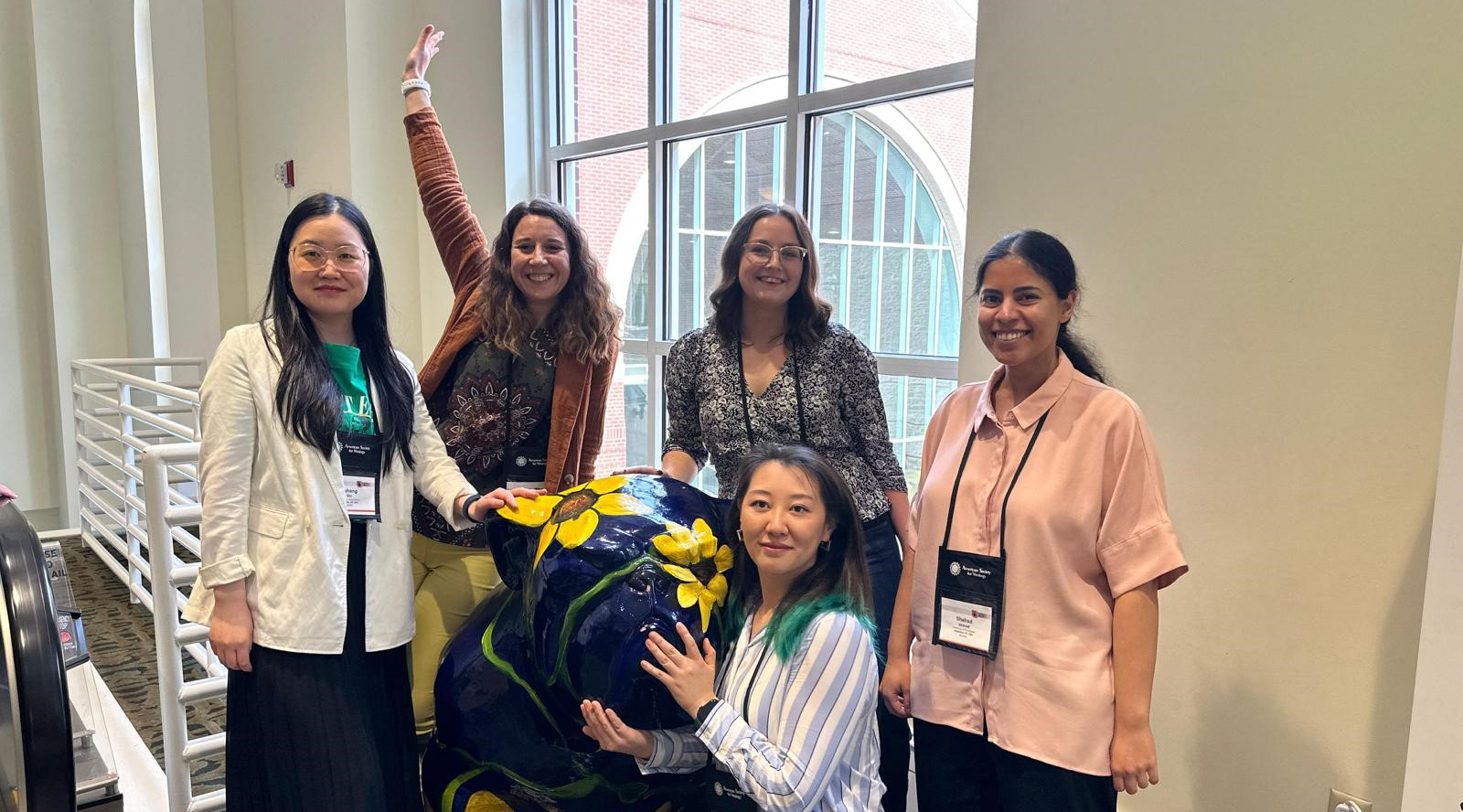
Welcome to the Serra-Moreno Lab
The Serra-Moreno lab studies the mechanisms by which human pathogens such as Human Immunodeficiency Virus (HIV), its close relative Simian Immunodeficiency Virus (SIV), and SARS-CoV-2 (the causative agent of COVID-19) circumvent the barriers of the innate immunity in their respective hosts and cause disease. Current projects in the lab are investigating the interplay between these human pathogens and the cellular factors Tetherin/BST2, SERINC5, BCA2 and autophagy.
Human immunodeficiency virus (HIV) is the causative agent of acquired immunodeficiency syndrome (AIDS), a disease that has caused 36 million deaths. Although current treatments are effective at keeping HIV to undetectable levels, they are unable to eliminate this virus from infected cells. Therefore, there is a critical need to find strategies to eradicate HIV. The research program in the Serra-Moreno lab focuses on understanding how HIV overcomes the innate immune barriers in its target cells to establish a chronic infection, with the goal of using this information to find new avenues for therapeutic intervention.
Coronaviruses have gained much attention recently due to the COVID-19 pandemic, caused by a novel coronavirus, SARS-CoV-2. SARS-CoV-2 shares 80% identity with SARS-CoV, an eradicated virus that emerged in the human population in 2002, after its transmission from bats. Both SARS-CoV and SARS-CoV-2 infect epithelial cells in the gastric and respiratory tract. However, SARS-CoV-2 is much more pathogenic, very stable, with many person-to-person transmissions, which can occur even before individuals exhibit any symptoms. The absence of symptoms during the dissemination phase has significantly complicated the implementation of contingency measures to avoid the global spread of SARS-CoV-2. At this moment, the only measures to prevent the transmission of the virus are social distancing and physical barriers: goggles, face masks and gloves. Therefore, there is a critical need to investigate the infectivity and pathogenicity features of SARS-CoV-2, so we can develop strategies to halt its propagation. Our lab is currently investigating the role of autophagy as a source of double membrane vesicles to create viroplasms, membrane factories for genome replication. We are also investigating the role of the antiviral factors BST2/Tetherin and SERINC5 in the restriction of SARS-CoV-2 as well as the countermeasures this virus has evolved to antagonize these cellular defenses.
Mentoring Philosophy
I personally mentor undergraduate and graduate students as well as post-doctoral fellows in my lab. As part of my mentoring strategies, I require rigor, diligence, and hard work, but I also encourage creativity and critical thinking. Everyone is part of a team, in which all voices are heard equally. As a research mentor, I supervise my mentees in a customized manner. Once they are used to the lab safety procedures and are proficient in general lab techniques, we (the student and I) decide on the mentoring approach that fits best the person's needs. Some trainees need more freedom and prefer having weekly meetings to report their progress. Others prefer more direct interactions on a daily basis. Regardless of the mentoring style, my purpose is to foster independent scientists able to lead their own research projects by applying critical thinking and scientific method to test their hypotheses in an unbiased manner. Therefore, mentees graduating from my lab are provided with a skillset that will allow them to successfully join the workforce, either in industry or academia.
If you are interested in joining the lab or learning more, please contact Dr. Serra-Moreno.

Ruth Serra-Moreno, Ph.D.
Principal Investigator
Selected Publications
Castro-Gonzalez, S., Shi Y., Colomer-Lluch, M., Song, Y., Mowery, K., Almodovar, S., Bansal, A., Kirchhoff, F., Sparrer, K., Liang, C., and Serra-Moreno, R. 2020. HIV-1 Nef counteracts autophagy restriction by enhancing the association between BECN1 and its inhibitor BCL2 in a PRKN-dependent manner. Autophagy. 2020 Feb 25.
Colomer-Lluch, M., Gonzalez-Castro, S., and Serra-Moreno, R. SUMOylation and Ubiquitination in HIV infection. Current Issues in Molecular Biology. Vol 35. 2020
Castro-Gonzalez, S., Colomer-Lluch, M., and Serra-Moreno, R. Barriers for a HIV cure: the latent reservoir. AIDS research and Human Retroviruses. 2018 Sep.
Colomer-Lluch, M. and Serra-Moreno R. 2017. BCA2/RABRING7 Interferes with HIV-1 Proviral Transcription by Enhancing the SUMOylation of IκBα. J Virol. 2017 March 29; 91(8).
Arias, J., Colomer-Lluch, M, von Bredow, B., Greene, J., MacDonald, J., O'Connor, D., Serra-Moreno, R., and Evans, D. 2016. Tetherin Antagonism by HIV-1 Group M Nef Proteins. J Virol. Sept. 2016 (JVI01465-16R1). PMID: 27654287
Colomer-Lluch, M., Gollahon L.S. and Serra-Moreno R. 2016. Anti-HIV factors: targeting each step of HIV's replication cycle. Curr. HIV. Res. 2016; 14(3):175-182
Serra-Moreno, R. 2014. The end of Nef's tether. Trends Microbiol. Dec; 22(12):662-664. PMCID: PMC4258156.
Nityanandam, R. and Serra-Moreno, R. 2014. BCA2/Rabring7 targets HIV-1 Gag for lysosomal degradation in a tetherin-independent manner. PLoS Pathogens. May 22;10(5):e1004151.
Serra-Moreno, R*., Zimmermann, K., Stern, L.J., and Evans, D.T. 2013. Tetherin/BST-2 Antagonism by Nef Depends on a Direct Physical Interaction between Nef and Tetherin, and on Clathrin-mediated Endocytosis. PLoS Pathogens. July;9(7):e1003487. *corresponding author
Serra-Moreno, R., and Evans D.T. 2012. Adaptation of Human and Simian Immunodeficiency Viruses for Resistance to Tetherin/BST-2. Current HIV Research. Jun;10(4):277-82.
Serra-Moreno, R., Jia, B., Breed, M., Alvarez, X., and Evans, D.T. 2011. Compensatory changes in gp41 restore resistance to tetherin in a pathogenic nef-deleted SIV. Cell Host & Microbe. Jan 20; 9(1): 46-57.
Evans, D.T., Serra-Moreno, R., Singh, R.K., and Guatelli, J.C. 2010. BST2/Tetherin: a new component of the innate response to enveloped viruses. Trends Microbiol. Sep 18(9): 388-396.
Jia, B*., Serra-Moreno, R*., Neidermyer, W., Rahmberg, A., Mackey, J., Fofana, I.B., Johnson, W.E., Westmoreland, S., and Evans, D. 2009. Species-specificity Activity of SIV Nef and HIV-1 Vpu in Overcoming Restriction by Tetherin/BST2. PLoS Pathog. May;5(5):e1000429. Epub 2009 May 15. *Both authors collaborated equally in this work.
Serra-Moreno R., Jofre J. and Muniesa M. 2008. The CI repressors of Shiga toxin-converting prophages are involved in coinfection of Escherichia coli strains, which causes a down regulation in the production of Shiga toxin 2. J Bacteriol. Jul;190(13):4722-35. Epub 2008 May
Serra-Moreno R., Jofre J. and Muniesa M. 2007. Insertion site occupancy by stx2 bacteriophages depends on the locus availability of the host strain chromosome. J Bacteriol. Sep;189(18):6645-54. Epub 2007 Jul 20.
Serra-Moreno R., Acosta S., Hernalsteens J.P., Jofre J. and Muniesa M. 2006. Use of the lambda Red recombinase system to produce recombinant prophages carrying antibiotic resistance genes. BMC Mol Biol. Sep 19;7:31
View All PublicationsAffiliations
Contact Us
Serra-Moreno Lab
601 Elmwood Ave
Rochester, NY 14642